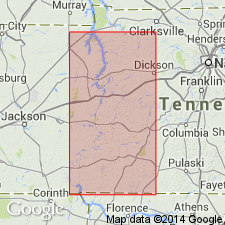
- Usage in publication:
-
- Birdsong shale
- Modifications:
-
- Named
- Dominant lithology:
-
- Shale
- AAPG geologic province:
-
- Cincinnati arch
Summary:
Birdsong shale named in this report. Unit is composed of bluish shaly limestone and shale, 35 to 65 feet thick. Unconformably underlies Decaturville chert and unconformably overlies Olive Hill formation. Typically developed along valley of Birdsong Creek, Benton Co., where it is about 45 feet thick. Very fossiliferous. Correlated with New Scotland. Included in Helderbergian or Linden group. Age is Early Devonian.
Source: GNU records (USGS DDS-6; Reston GNULEX).
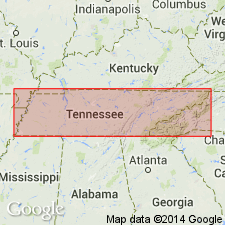
- Usage in publication:
-
- Birdsong shale member
- Modifications:
-
- Revised
- AAPG geologic province:
-
- Cincinnati arch
Summary:
Pg. 280, 282 (fig. 83), 292-296. Birdsong shale member of [/]Ross formation. Rank reduced to member status in [/]Ross formation (new). Conformably overlies Rockhouse limestone member; unconformably underlies Flat Gap limestone, Harriman formation, or Camden formation; grades southward into [/]Ross limestone member of Ross formation. Basal 8 to 10 feet of Birdsong as described by Dunbar, 1919 (Tennessee Div. Geology Bull., no. 21) is Rockhouse limestone member of this report. Thickness 25 to 40 feet; locally 60 feet. Includes interbeds referred to as Decaturville chert zone. [Age is Early Devonian.]
[Name Ross preempted by Ross Limestone of Foerste (1903), which = Ross limestone member of author. The application of an identical geographic name to a stratigraphic unit and its parts (Ross limestone member of Ross formation) conflicts with nomenclature guidelines (CSN, 1933; ACSN, 1961, 1970; NACSN, 1983, 2005, 2021). Precise duplication of geographic names of sedimentary units shall not be allowed, except as a most urgent necessity because of scarcity of available names or other conditions, and then only if geographic and stratigraphic separation is such as to preclude any possible chance of confusion (CSN, 1933).]
Source: Modified from US geologic names lexicon (USGS Bull. 1200, p. 347-348).
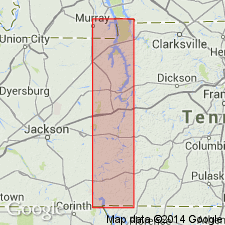
- Usage in publication:
-
- Birdsong Shale Member
- Modifications:
-
- Overview
- AAPG geologic province:
-
- Cincinnati arch
Summary:
Most terrigenous-rich unit (of 5) in the Ross Formation. 12-15 m thick. Upper unit of Ross in northern facies; interfingers with Ross Limestone Member to south. Gradationally over Rockhouse Limestone Member. Age is Early Devonian.
Source: GNU records (USGS DDS-6; Reston GNULEX).
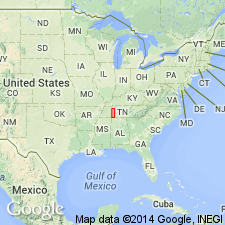
- Usage in publication:
-
- Birdsong Formation
- Modifications:
-
- Revised
- AAPG geologic province:
-
- Cincinnati arch
Summary:
Birdsong referred to as Formation in this report as it consists of diverse lithologies. Field investigation and analysis of Lower Devonian ostracode fauna indicate that the Birdsong Formation, the Rockhouse Formation, the "Rockhouse" Limestone, and the Ross Limestone represent facies of a single depositional episode.
Source: GNU records (USGS DDS-6; Reston GNULEX).
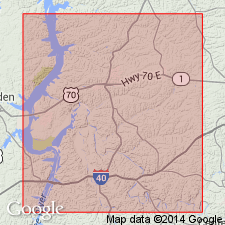
- Usage in publication:
-
- Birdsong Shale Member*
- Modifications:
-
- Age modified
- AAPG geologic province:
-
- Cincinnati arch
Summary:
Birdsong Shale Member of Ross Formation occurs in du Pont Geohydrological Survey well near Waverly, Humphreys Co., central TN. Assigned an Early Devonian (Lochkovian to Pragian) age.
Source: GNU records (USGS DDS-6; Reston GNULEX).
For more information, please contact Nancy Stamm, Geologic Names Committee Secretary.
Asterisk (*) indicates published by U.S. Geological Survey authors.
"No current usage" (†) implies that a name has been abandoned or has fallen into disuse. Former usage and, if known, replacement name given in parentheses ( ).
Slash (/) indicates name conflicts with nomenclatural guidelines (CSN, 1933; ACSN, 1961, 1970; NACSN, 1983, 2005, 2021). May be explained within brackets ([ ]).

